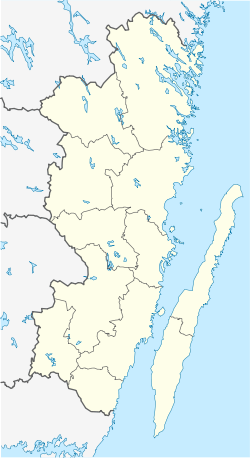Kalmar
| Kalmar | ||
|---|---|---|

Storgatan in Kalmar
|
||
|
||
| Coordinates: 56°39′41″N 16°21′46″E / 56.66139°N 16.36278°ECoordinates: 56°39′41″N 16°21′46″E / 56.66139°N 16.36278°E | ||
| Country | Sweden | |
| Province | Småland | |
| County | Kalmar County | |
| Municipality | Kalmar Municipality | |
| Charter | 1100 | |
| Area | ||
| • City | 19.50 km2 (7.53 sq mi) | |
| Elevation | 8 m (26 ft) | |
| Population (31 December 2010) | ||
| • City | 36,392 | |
| • Density | 1,866/km2 (4,830/sq mi) | |
| • Metro | 61,533 | |
| Time zone | CET (UTC+1) | |
| • Summer (DST) | CEST (UTC+2) | |
| Postal code | 39x xx | |
| Area code(s) | (+46) 480 | |
| Website | kalmar |
|
Kalmar is a city in the southeast of Sweden, situated by the Baltic Sea. It had 36,392 inhabitants in 2010 and is the seat of Kalmar Municipality. It is also the capital of Kalmar County, which comprises 12 municipalities with a total of 236,399 inhabitants (2015).
From the thirteenth to the seventeenth centuries, Kalmar was one of Sweden's most important cities. Between 1602 and 1913 it was the episcopal see of Kalmar Diocese, with a bishop, and the Kalmar Cathedral from 1702 is still a fine example of classicistic architecture. It became a fortified city, with the Kalmar Castle as the center. After the Treaty of Roskilde in 1658, Kalmar's importance diminished, until the industry sector was initiated in the 19th century. The city is home to parts of Linnaeus University.
Kalmar is adjacent to the main route to the island of Öland over the Öland Bridge.
The area around Kalmar has been inhabited since ancient times. Excavtions have found traces of stone age gravefields. The oldest evidence for there being a town are however from the 11th century. According to a medieval folk tale, the Norwegian king Saint Olav had his ships moved to Kalmar. The oldest city seal of Kalmar is from somewhere between 1255 and 1267, making it the oldest known city seal in Scandinavia.
In the 12th century the first foundations of a castle were established, with the construction of a round tower for guard and lookout. The tower was continuously expanded in the 13th century, and as such, Queen Margaret called an assembly there between the heads of state of Sweden and Norway, and on 13 July 1397, the Kalmar Union treaty was signed, which would last until 1523. Kalmar's strategic location, near the Danish border (at the time the Scanian lands, i.e. the provinces of Blekinge, Halland and Scania, were part of Denmark), and its harbour and trade, also involved it in several feuds. There are two events independently labelled the Kalmar Bloodbath, 1505: the first in 1505, when King John of Denmark, Norway, and Sweden had the mayor and city council of Kalmar executed; the second in 1599 by command of Duke Charles, later to become King Charles IX of Sweden.
...
Wikipedia



